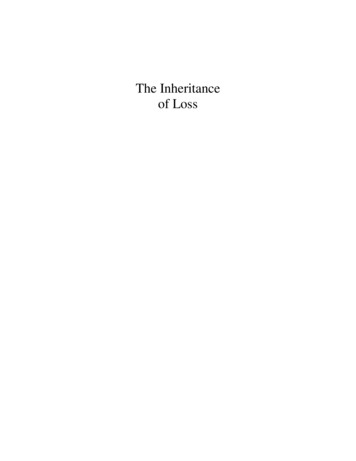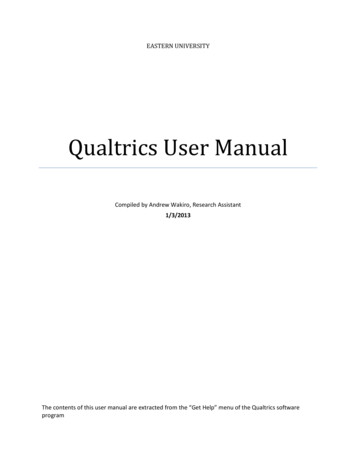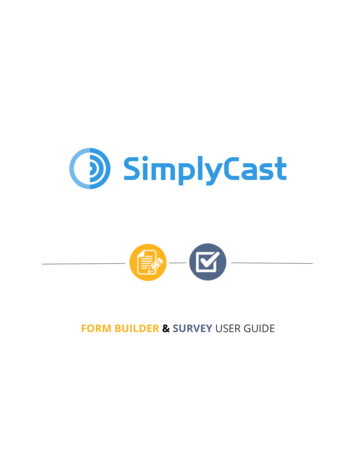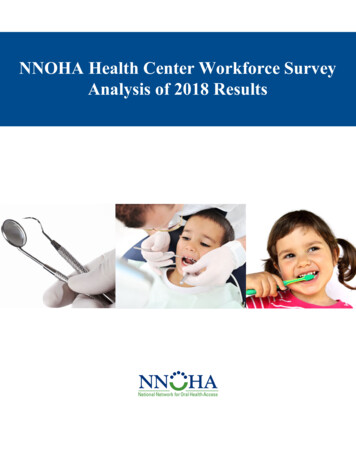
Transcription
2020THE SANOFICANADAHEALTHCARESURVEYCANADA’S PREMIER SURVEYON HEALTH BENEFIT PLANSFutureForwardFrontline Perspectives on theFuture of Health Benefit Plans
THE SANOFI CANADAHEALTHCARE SURVEY2020Table of contentsCHAPTER 1The Wellness Picture4A better understanding of wellness in the workplace6Taking the pulse of personal health8Mental health: A call to actionThank you toour SponsorsFor 23 years, The Sanofi CanadaHealthcare Survey has monitoredthe pulse of health benefit plans,analyzing the changing opinions ofplan members and plan sponsorson topics including workplacewellness, health concerns and theimpact of chronic disease.DIAMOND SPONSORS:10 Stepping up for chronic disease management12 Spotlight: Asthma and atopic dermatitisCHAPTER 2Value of Health Benefit Plans14 Making quality connections16 A sense of purpose18 Design also matters20 Employer profile: Cornerstones for wellnessCHAPTER 3Closer Look at the Drug Plan22 Putting adherence on the agenda23 Coverage for higher-cost drugs24 Spotlight: An analysis of cost drivers25 Opinions on national pharmacarePLATINUM SPONSORS:CHAPTER 4Future Considerations26 Opportunities and challenges31 Future directions for health benefits34 Driving toward better value35 Spotlight: Immunization against infectious diseases36 Forward Thinking: 7 steps into the futureCOVID-19 PANDEMICPlease note that The Sanofi Canada Healthcare Survey wasconducted in January 2020, before the COVID-19 pandemicwas declared on March 11th. Members of the advisoryboard met to discuss the survey results on February 20th.The report was written in March and April.2THE SANOFI CANADA HEALTHCARE SURVEY 2020CANADA’S PREMIER SURVEY ON HEALTH BENEFIT PL ANS
THE SANOFI CANADAHEALTHCARE SURVEY2020Health, our mostprecious commodityMARISSA POOLEGeneral Manager, SANOFI GENZYMECountry Lead, SANOFI CANADA2020 will be remembered as the year the world stoodstill. Yet it will also be remembered as the year when wemobilized like never before to protect ourselves and ourloved ones from the invisible, deadly threat of COVID-19.While the costs of worldwide lockdowns will beformidable, the costs of not shutting down would havebeen incomprehensible. The more we learn about thiscapricious disease, the more we realize that, had it spreadunchecked, it would have crippled our economies, ourhealthcare systems and our daily lives.Some describe COVID-19 as a wake-up call on manyfronts. Perhaps first and foremost, it serves as a reminderthat health is our most precious commodity. Bothindividually and at the population level, good health is anessential predictor for success. And when one becomesill, be it due to an infectious or chronic disease, a returnto sufficient good health is paramount for personalproductivity and happiness and societal prosperity.COVID-19 threw this simple truth into sharp relief.Sanofi is in a unique position where through global effortswe’re working toward solutions to support detection,prevention and treatment of COVID-19. We have a clinicalstudy looking at the efficacy of IL-6 receptor blockerin COVID‑19 patients as well as a partnership with acompany called Luminostics to develop a smartphonebased self-testing solution for COVID-19. When it comesto the COVID vaccine, Sanofi’s global efforts to produceone include multiple approaches with partners likeBARDA, Translate Bio and GSK.Beyond the vaccine, we are more resolved than ever tocollaborate with additional key stakeholders, including thebenefits community. We are proud to continue to partnerwith insurance carriers and other benefit providers toproduce The Sanofi Canada Healthcare Survey, now in its23rd year. Improved health is our common mission, and welook forward to increased collaboration in the years ahead.Future ForwardANDREA FRANKELPrivate Payer LeadSANOFI CANADAWhen we selected a theme for this year’s edition of TheSanofi Canada Healthcare Survey, we felt that “FutureForward” would be appropriate given the start of thesecond decade of the 21st century. Little did we knowwhat a pivotal year 2020 would be in terms of planningfor the future, given the explosive impact of COVID-19 justweeks after the survey results came in.We hope you agree the results provide a conclusivesummary of our priorities going forward. If anything, thenew realities of a post-COVID world serve to reinforcethese priorities, while also opening our minds to newpossibilities in health benefits. Among the highlights: Vaccinations against infectious diseases and virtualcare top the list of desired benefit offerings for both planmembers and plans sponsors.CANADA’S PREMIER SURVEY ON HEALTH BENEFIT PL ANS Plan sponsors increasingly want to do more to supportplan members with chronic disease (who are at highestrisk of complications due to infectious disease). Plan members between the ages of 18 and 34 are farmore likely to take sick days or report reduced productivityat work due to stress and chronic health conditions. Plan members confirm that a health benefit plan and awellness culture in the workplace are strong incentives tostay with an employer.This year’s report also includes “Forward Thinking: 7 Stepsinto the Future,” a handy one-page wrap-up of key findingsand action steps (page 36). As we all consider the future ofhealth benefit plans in a world that’s quite unlike what it was atthe start of this year, we sincerely hope that the 2020 editionof The Sanofi Canada Healthcare Survey helps map your way.THE SANOFI CANADA HEALTHCARE SURVEY 20203
The Wellness PictureCHAPTER 1 SECTION 1A better understandingof wellness in the workplaceSurvey results confirm that a workplace environment or culture that supports personal health andwellness provides dividends to employers as well as employees. This year’s survey takes a look atwhat comprises a positive wellness culture, with a majority of plan sponsors signalling their continuedcommitment to employee wellness.Workplace culture takes centre stage Seventy-seven percent of plan members agree thattheir workplace culture or environment encourageshealth and wellness, unchanged from last year.A wellness culture is a consistent determinant ofratings in other areas, including personal healthand job satisfaction (see chart). When broken down by size, 71% of plan members working in organizations with fewer than50 employees agree that they have a wellnessculture, compared to 82% among those workingfor organizations with 500 or more employees. Eighty-eight percent of plan sponsors agree thatthey have a wellness culture, again an importantdeterminant of ratings in other areas. Theseemployers are more likely to invest in wellness areasoutside of health benefits, such as personal financialplanning (78% versus 54% among those without awellness culture), and to have specific objectivesfor their health benefit plans (64% versus 36%). Eighty-six percent of plan members agree that aworkplace environment that encourages healthand wellness is an important factor when decidingon a job offer or remaining at an organization;29% strongly agree.What builds a wellness culture? When presented with a list of 13 possible factors,both plan members (55%) and plan sponsors(67%) most often select safety as a way theirenvironment encourages health and wellness.This increases to 70% among plan members inthe utilities/resources/transport sector. Good relationships with co-workers are virtuallytied at the top for plan members (54%), followedby a good relationship with their immediatesupervisor (44%). While plan members and plan sponsors generallyagree about the ranking of factors, plan membersare less likely to indicate that their own organizationis active in certain areas, such as reasonable workloads (see chart).4THE SANOFI CANADA HEALTHCARE SURVEY 2020PLAN MEMBERSHOW A WELLNESS CULTURE INFLUENCES PLANMEMBERS’ PERCEPTIONS THAT:n With wellness culturen WithoutPersonal health isexcellent/very good38%50%They are satisfiedwith their job90%61%Quality of health benefitplan is excellent/good48%74%SOURCE: The Sanofi Canada Healthcare Survey. January 2020. BASE: Plan members witha wellness culture (n 1,146); Plan members without a wellness culture (n 359)JOHN McGRATH ZLC FINANCIAL“A culture of wellness doesn’thappen by accident. If we’re goingto do this right and create the valueproposition around it, as advisors we needto make sure we cover this off as part of ourchecklist of discussion points. That may notbe easy when clients barely have time tomeet at all, so let’s get creative. Let’s helpcreate the momentum.”KNOWLEDGE GAPWORKING FROM HOMERESPONDENTS WHO SAY THEIRORGANIZATION ALLOWS EMPLOYEESTO WORK FROM HOMEPLAN MEMBERSPLAN SPONSORS26%40%Increasing to 54%among plan sponsorsin the professionalservices/high-tech/financial sectorSOURCE: The Sanofi Canada Healthcare Survey. January 2020. BASE: All plan members(N 1,500); All plan sponsors (N 516)CANADA’S PREMIER SURVEY ON HEALTH BENEFIT PL ANS
PLAN MEMBERSPLAN SPONSORSTHE WAYS IN WHICH THE WORK ENVIRONMENTENCOURAGES HEALTH AND WELLNESSn Plan membersn Plan sponsorsSafe work environment55%Good relationshipswith co-workers54%56%Good relationship withimmediate supervisor/manager44%54%HR policies (e.g., vacation,paid personal days off)42%Areas to take breaks, socialize(e.g., lunchrooms)Reasonable workloadRelaxed atmosphere39%48%Social activities at or outsideof work (e.g., potluck lunches,community events)28%39%Well-designed personalworkspaces (e.g., goodlighting, ergonomic design)28%39%Healthy foods and snacksin cafeteria, in vendingmachines, at meetings, etc.PLAN SPONSORSPLAN SPONSORS WHO PLAN TO INVEST IN HEALTHAND WELLNESS AREAS OUTSIDE OF THE HEALTHBENEFIT PLAN IN THE NEXT THREE YEARS88% 500 or more employeesHave a specific objective30%41%Official wellness programs(e.g., fitness challenges, etc.)46%54%Flexible work arrangements(e.g., flexible hours,work from home)Good leadership fromsenior executives/owners55% Over the next three years, 74% of plan sponsors plan todedicate funding and/or staff resources outside of thehealth benefit plan to at least one out of five possiblehealth and wellness areas. Among them, they will mostlikely do so in the area of emotional/mental health (58%),followed by the prevention of illness and/or managementof chronic conditions (49%), physical fitness (45%), socialwell-being (44%) and financial well-being (40%). Forty percent of plan sponsors offer incentives foremployees to participate in health and wellness programs or activities, up from 30% in 2015, and increasingto 50% among plan sponsors who get reporting on thetop disease states in their organization. When asked which actions or incentives are most effective,plan sponsors most often cite senior leadership that setsthe example (42%), followed by individual financial awards(e.g., gift cards) (36%) and a wellness account (33%).HIGHS LOWS35%30%67%Continued commitment to wellness89% for the health benefit planin the coming yearReceive analyses of top27%42%26%30%17%25%SOURCE: The Sanofi Canada Healthcare Survey. January 2020. BASE: Plan memberswith a wellness culture (n 1,146); Plan sponsors with a wellness culture (n 448)SHANNON DARVILL SILVERBERG GROUP, A PEOPLE CORPORATION COMPANY“The message is clear that thehigh marks go to workplaces witha positive wellness culture. Allstakeholders—plan sponsors, insurancecarriers and consultants—can really buildon that together. And for employers whodon’t have a wellness culture—yet—wecan make it a goal to bring them onside,one small step at a time.”CANADA’S PREMIER SURVEY ON HEALTH BENEFIT PL ANS84% disease statesFewer than 50 employees52%Do not have a specificobjective53%Do not receive analyses oftop disease states54%SOURCE: The Sanofi Canada Healthcare Survey. January 2020. BASE: All plan sponsors (N 516)KEY TAKEAWAYS1. A wellness culture plays an important role inattraction and retention as well as job satisfaction,which in turn drives productivity. More can be doneto capitalize on this, given the gap between planmembers’ and plan sponsors’ perceptions on whatcontributes to a wellness culture.2. Plan members’ top three factors for a positivewellness culture are safety, good relationships withco-workers and a good relationship with the immediate supervisor.3. Alternate work arrangements are highly valuedby some workforces; to facilitate that, plan sponsors on The Sanofi Canada Healthcare Surveyadvisory board recommend moving away fromstandardized, possibly limiting, policies toward amore informal, employee-centric approach.4. Senior leadership and fun activities (such asonline team challenges) are essential, includingnon financial incentives to boost engagement inhealth and wellness initiatives. Leaders and managers may also need to provide time for participation,particularly among shift workers.THE SANOFI CANADA HEALTHCARE SURVEY 20205
The Wellness PictureCHAPTER 1 SECTION 2Taking the pulseof personal healthPlan members report generally good health; however, those in poor health are much more likely to indicatethat their health benefit plan does not meet their needs. More plan members are using at least one digitaldevice to help achieve health or fitness goals, which presents opportunities for benefits providers.Health and job satisfaction linked Forty-seven percent of plan members report being in excellent or very good health and 44% in good health, leaving just8% in poor health. These results are similar to previous years. Job satisfaction can have an influence on health (see chart).As well, plan members in poor health are far less likelyto agree that their health benefit plan meets their needs(49%, compared to 72% among those in excellent/verygood health).PLAN MEMBERSPLAN MEMBERS’ DESCRIPTION OF PERSONALHEALTH OVER THE PAST YEARn Excellent/very goodn Goodn Poor8%47%44%Greater use of digital tools Fifty-three percent of plan members used at least onedigital device or mobile app to help achieve personal healthor fitness goals in the past year, up from 32% in 2015.They are most likely to use a fitness tracking device (28%),followed by an app (23%). Plan members aged 18 to 34 (70%) are much more likelyto use a device or app than plan members aged 55 andolder (31%). In 2015, plan members in excellent/very good health (38%)were more likely to use a device or app than those in poorhealth (26%). This year’s results of 60% and 54%, respectively, suggest the gap is closing. Fifty-six percent of plan members with chronic conditionsused a device/app in the past year, up from 34% in 2015,and compared to 47% among those without chronicconditions.PLAN MEMBERSn 2015Fitness tracking devices(e.g., Fitbit)Apps for mobile devices (e.g.,exercise, medication reminders)Web sites (e.g., to set personalgoals and track outcomes)Online health riskassessment tools*28%12%11%23%Any of the above15%32%53%*To provide overall picture of health and determine personal risk factors for illness basedon weight, stress, etc.); SOURCE: The Sanofi Canada Healthcare Survey. January 2020.BASE: All plan members (N 1,500)6THE SANOFI CANADA HEALTHCARE SURVEY 2020Not satisfied with jobHealth benefit plandoes not meet needs24%18%15%SOURCE: The Sanofi Canada Healthcare Survey. January 2020. BASE: All plan members(N 1,500)KEY TAKEAWAYS1. The increased use of digital devices and appsto help achieve health or fitness goals is encouraging—particularly among plan members withpoor health or a chronic condition or disease,who were historically less likely to use these tools.3. HRA participation rates jump significantlywhen incentives are in place, observe insurers and plan sponsors on the advisory board.Personal financial incentives (e.g., gift cards) aremost effective.15%10%8%Taking three ormore medications2. Members of the advisory board emphasize theopportunity to renew efforts for plan members tocomplete insurers’ online health risk assessments(HRAs), since they can offer up a “bedrock” ofvalidated data for employers to design, revise andupgrade health benefit plans.PLAN MEMBERS’ USE OF DIGITAL DEVICES/MOBILE APPS FOR PERSONAL HEALTHOR FITNESS IN THE PAST YEARn 2020POOR HEALTH MORE LIKELY WHEN:4. Participation also improves when the HRAis a visually appealing “app-like” experience thatavoids clinical language.CANADA’S PREMIER SURVEY ON HEALTH BENEFIT PL ANS
Everyone benefits froma healthy workplaceGet started on yoursLearn howFinancialPhysicalMentalContact your advisor or yourCanada Life group representative.canadalife.com 1-800-957-9777Canada Life and design are trademarks of The Canada Life Assurance Company. 79-00541-04/20
The Wellness PictureCHAPTER 1 SECTION 3Mental health: a call to actionThe incidence and impact of high levels of stress are disconcerting, especially among youngeremployees. The advisory board applauds plan sponsors who have increased maximums for mentalhealth counselling services and emphasizes that more can be done in the area of prevention.Stress very much a factor Thirty percent of plan members report high levels ofstress on a typical day over the past three months,comparable to 33% in 2018, and increasing to 52%among plan members who are not satisfied withtheir job and 48% among those in poor personalhealth. Age is also a factor: plan members aged 18to 34 (34%) are more likely to report high levels ofstress than those 55 and older (22%). The top three sources of stress are personal finances(39%), workload (34%) and work-life balance (32%).These results are similar to two years ago, whenthe question was last asked; however, interactionswith people at work have moved up to become thefourth-highest source of stress (see chart). Thirty-seven percent of plan members agree thatworkplace stress has been so overwhelming in thepast year that they have felt physically ill, a resultthat has been relatively consistent since the question was first asked in 2009. It increases to 63%among those who are not satisfied with their jobsand to 52% among those who say that interactionsat work are a main source of stress. And again,those aged 18 to 34 (42%) are much more likelythan those aged 55 and older (23%) to say theyhave felt physically ill as a result of stress. When it comes to work-related stress, plan members are somewhat equally divided about the mainsource of the stress: 36% say it is the work environment (e.g., physical space, supervisor, co-workers)and 30% say it is the job itself. The remaining 35%say both are the main causes of stress. Plan members aged 18 to 34 (42%) are much more likely thanthose aged 55 or older (28%) to indicate the environment is the main source of work-related stress.Impact on productivity Thirty-six percent of plan members mention theyarrived late or left work early due to stress at leastonce in the past year; among those who did, theyarrived late or left early an average of 4.9 times.Younger plan members are more likely to be absentin this way, as are those in poor health (see chart). Forty-one percent of plan members took at leastone full sick day off due to stress in the past year;those who did missed an average of 5.1 days duringthe year. Again, age and health influence results(see chart).8THE SANOFI CANADA HEALTHCARE SURVEY 2020BILL PAPADIMITRIOU DESJARDINS INSURANCE“Mental illness has reached alarminglevels among teens and studentsin universities, and that’s our futureworkforce. We already see the shift in claimsdata. The solution is not just about more money,it’s about using technology to improve accessand increase cost-effectiveness. We have toget at this now, or else mental health claims atstaggering levels are going to be the new norm.”PLAN MEMBERSMAIN SOURCES OF STRESS139% Personal finances234% Workload332% Balancing work and life responsibilities427% Interactions with people at work523% Personal relationshipsSOURCE: The Sanofi Canada Healthcare Survey. January 2020. BASE: All plan members (N 1,500)PLAN MEMBERSSTRESS AND ABSENTEEISM IN THE WORKPLACEn All plan membersn Plan members in poor health36%45%Plan members who arrived late or leftwork early due to stress in the past yearAverage number of times plan membersarrived late or left work early4.941%Plan members who took at least one fullsick day due to stress in the past yearAverage numberof sick days9.45.153%10.9SOURCE: The Sanofi Canada Healthcare Survey. January 2020. BASE: All plan members (N 1,500)CANADA’S PREMIER SURVEY ON HEALTH BENEFIT PL ANS
Support for mental healthMARK ROLNICK SHOPPERS DRUG MART“Cost, stigma and issues aroundaccess can be huge barriersfor mental health. Some plansponsors are prepared to increase theirparamedical maximum for mental healthproviders, which is a good thing to helpaddress the cost barrier. However, wecan help more people while addressingstigma and access challenges byconsidering the proven benefits ofscalable digital solutions.”HIGHS LOWSPLAN SPONSORSPLAN SPONSORS WITH MENTAL HEALTH TRAININGPROGRAMS FOR MANAGERS AND/OR EMPLOYEES72%500 or more employeesFewer than c-basedWestern Canada-based44%66%Public sectorPrivate sector46%65%Receive analyses of topdisease statesDo not receive analysesof top disease states21%SOURCE: The Sanofi Canada Healthcare Survey. January 2020. BASE: All plan sponsors (N 516) Sixty-one percent of plan members state their employereffectively helps employees manage stress, up from 42% in2011. More plan sponsors (74%) also report they effectivelyhelp staff manage stress, up from 58% in 2011. Among plan members experiencing high levels of stress on atypical day, 53% say their employer effectively helps employees manage stress. Fifty-one percent of plan sponsors have a mental health training program in place for managers and/or employees to helpthem recognize and appropriately respond to signs of mentalillness, unchanged from 2019. This result varies somewhat bythe size of workforce, region and other factors (see chart). Eighteen percent of plan sponsors recently increased themaximum amount of coverage for counselling servicesrelated to mental health (e.g., psychiatry, psychotherapy,etc.). Unionized workforces (29%) and public sectoremployers (29%) were more likely to do so. An additional25% of plan sponsors intend to increase the maximum. The current median annual maximum coverage for counselling services related to mental health is 1,011. The majority(68%) have a maximum that is less than 1,000.KEY TAKEAWAYS1. Younger employees report higher levels of stressand are much more likely to require time off work as aresult—this is an urgent call to action for all stakeholdersto better understand the causes and possible solutions,state members of the advisory board.PLAN MEMBERS2. On the surface, organizations appear to be moreeffective at helping employees manage stress. However, this perception by plan members and plan sponsors may not consider the growing rate of stress, sincereported levels have not declined and the negativeimpact on job performance is high.LEVELS AND IMPACT OF STRESS:A COMPARISON BY AGEn Between ages 18 and 34n 55 years and olderHigh levels of stress on a typicalday over the past three months22%Workplace stress sooverwhelming in the past yearthat they have felt physically illArrived late or left early dueto stress in the past year34%23%47%17%Took at least one sick daydue to stress in the past year42%21%50%SOURCE: The Sanofi Canada Healthcare Survey. January 2020. BASE: All plan members(N 1,500)PLAN SPONSORSCHANGES TO THE MAXIMUM OFCOVERAGE FOR COUNSELLINGSERVICES FOR MENTAL HEALTHPlan sponsors whorecently increasedPlan sponsorswho plan to18%25%SOURCE: The Sanofi Canada Healthcare Survey. January 2020.BASE: All plan sponsors (N 516)CANADA’S PREMIER SURVEY ON HEALTH BENEFIT PL ANS 1,011Medianannualmaximum3. The advisory board members recommend thatmental health training expands beyond support formental illness to include preventative measures suchas resilience training. For plan sponsors with employeeassistance programs, managers can be trained toknow what’s available across the healthcare continuum (from prevention to treatment).4. Internet-based cognitive behavioural therapy(iCBT) is an emerging option; in the disability space,insurers on the survey advisory board report significantreductions in the duration of leaves when iCBT isavailable for plan members.5. Increased maximums for mental health counsellingservices are the right move, agree members of theadvisory board—furthermore, it signals that fundingcan be made available for benefits that better meet theneeds of plan members. On a related note, the advisory board recommends expanding the list of eligibleproviders to include, for example, social workers.THE SANOFI CANADA HEALTHCARE SURVEY 20209
The Wellness PictureCHAPTER 1 SECTION 4Stepping up for chronicdisease managementTwo-thirds of plan members live with a chronic condition and/or chronic pain, and more than half ofthem report negative impacts on job performance as a result. Younger employees especially appearto be struggling. The advisory board calls on all stakeholders to take more assertive actions to supportthese plan members, which in turn will help manage associated costs.Dominant presence in workforce Consistent with previous years, more than half of plan members(58%) report having at least one chronic condition, increasing to70% among those aged 55 and older and 93% among those inpoor health. The top conditions are mental illness (20%), hypertension (12%),high cholesterol (12%), arthritis (11%), asthma/lung disease (9%)and diabetes (8%). Plan sponsors, meanwhile, estimate that just 34% of theirworkforce has a chronic condition.Factoring in chronic pain Forty-eight percent of plan members report experiencing chronicpain (i.e., pain that never really goes away, or lasts for months,or “flares up” from time to time), compared to 42% in 2019.This increases to 58% among those with diabetes and to83% among those with arthritis. When other chronic conditions and diseases are factored in,70% of plan members report having a chronic condition and/orchronic pain. Fifty-three percent of plan members are concerned about theirchronic condition, increasing to 67% when chronic pain is factored in. Levels of concern regarding their condition and/or painare highest among those with arthritis (81%) and diabetes (79%).Huge impact on productivity Thirty-eight percent of plan members report that their chronic condition has caused them to miss work or made it harder to do theirjob, down from 47% in 2018 and comparable to 38% in 2016. When chronic pain is added to the equation, the result jumps to58% who report they have missed work or found it harder todo their job. Younger employees (aged 18 to 34) and those withcertain conditions are most likely to report these negative impactson job performance (see charts). When asked to describe how their condition and/or chronic paincaused them to miss work or made it harder to do their job, tiredness or fatigue was by far the number one factor (51%), followedby time off for healthcare appointments (35%), difficulty concentrating (32%) and leaving work early due to feeling ill (31%). Fifty-one percent of plan members with a chronic conditionand/or chronic pain arrived late or left work early due to theircondition in the past year; among those who did, they arrived lateor left early an average of 4.7 times. Younger plan members aremore likely to be absent in this way, as are those with a mentalillness (see charts).10THE SANOFI CANADA HEALTHCARE SURVEY 2020SUSAN BELMORE-VERMES HEALTH ASSOCIATION NOVA SCOTIA“It can be a struggle to getthe data to support futureactions. Plan sponsorswant to do more in chronic diseasemanagement support, but we needconstructive, integrated claims dataanalyses. We need simple benchmarksto tell us if we’re above, below or ontrack. Insurers and advisors who do thiscan really set themselves apart—andplan sponsors need to seek them out.”KNOWLEDGE GAPCHRONIC DISEASE IN THE WORKPL ACEPLAN MEMBERSPLAN SPONSORSPLAN MEMBERSWHO HAVE BEENDIAGNOSEDWITH AT LEASTONE CHRONICDISEASE ORCONDITIONPLAN SPONSORS’ESTIMATE OFPERCENTAGE OFWORKFORCEWITH A CHRONICDISEASE ORCONDITION58%34%SOURCE: The Sanofi Canada Healthcare Survey. January 2020. BASE: All planmembers (N 1,500); All plan sponsors (N 516)DR. ALAIN SOTTO MEDCAN WELLNESS CLINIC & TORONTO TRANSIT COMMISSION“Employers must ensure thesafety of their employees—that’s the law. But you can’treally be safe at work without beinghealthy first. Employees who strugglewith chronic diseases may contributeto workplace injuries. When we makethat paradigm shift that recognizes thathealth benefits are part of the safetystrategy, health and wellness solutionsare far more likely to fall into place.”CANADA’S PREMIER SURVEY ON HEALTH BENEFIT PL ANS
PLAN MEMBERSCHRONIC CONDITIONS AND/OR CHRONIC PAIN70%48%Plan members witha chronic conditionand/or chronic painPlan memberswith chronicpainSOURCE: The Sanofi Canada Healthcare Survey. January 2020. BASE: All planmembers (N 1,500)PLAN MEMBERS58%PLAN MEMBERS WHO MISSEDWORK OR FOUND IT HARDERTO DO THEIR JOB DUE TO ACHRONIC CONDITION AND/ORCHRONIC PAIN74%Havearthritis73%69%Have asthma/lung diseaseHave mentalillnessSOURCE: The Sanofi Canada Healthcare Survey. January 2020. BASE: Plan memberswith a chronic condition and/or chronic pain (n 1,096)PLAN MEMBERSIMPACT OF CHRONIC CONDITIONS AND/ORCHRONIC PAIN IN THE WORKPLACEn All plan members n Have mental illnessn Have asthma/lung disease51%64%63%Arrived late or left work earlydue to a chronic condition and/or chronic pain in the past yearAverage number of timesarrived late or left work early4.74.5Average number of sick days63%71%73%6.06.08.0SOURCE: The Sanofi Canada Healthcare Survey. January 2020. BASE: Plan memberswith a chronic condition and/or chronic pain (n 1,096)TELENA OUSSOREN SUNCOR“A key message for employersis to try to not boil the ocean.Focus on one tactic that mayhelp plan members manage theirchronic condition. Building on thesesuc
of chronic conditions (49%), physical fitness (45%), social well-being (44%) and financial well-being (40%). Forty percent of plan sponsors offer incentives for employees to participate in health and wellness pro-grams or activities, up from 30% in 2015, and increasing to 50% among plan sponsors who get reporting on the










